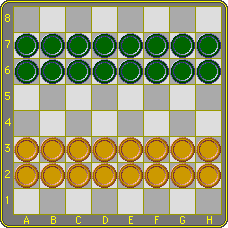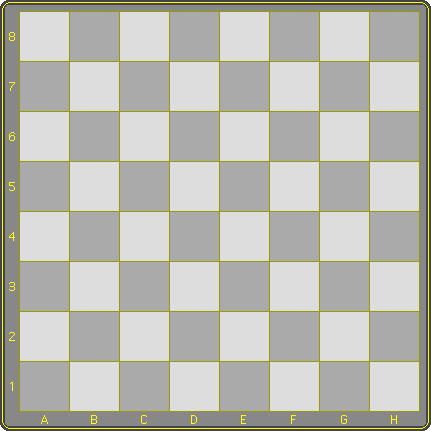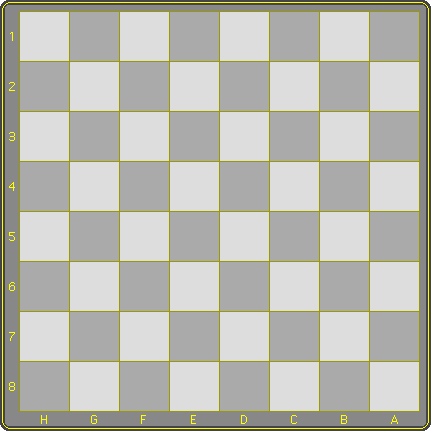Page 1 of 2
Armenian Draughts is a renegade variant of the traditional 'straight' branch of Draughts games in that it is a 'doublegrid' game: it introduces a diagonal move in a traditionally straight system, much the same as Frisian Draughts introduces a straight capture in a traditionally diagonal system. These games are therewith the first truly modern games. We did mention as much in The split in two branches in the history section.Shorthand rules
The shorthand rules are simple for those who are familiar with Turkish Draughts. Armenian is the same as Turkish, except that a man may also move one square diagonally forwards, and a king may also move any distance diagonally. All capture remains orthogonal only.
Play Armenian Draughts interactively or against an AI
Rules
The rules mention men and kings. A king is a promoted man. If the difference doesn't matter, they may also mention pieces, for instance 'the number of pieces on the board'.
 | The diagram shows the board and the pieces in initial position. There are two players, black and white. White begins. Players move, and must move, in turn. Moving Capture has precedence over a non-capturing move. If the player to move has no capture to make, he has two options:
A king moves any number of unobstructed squares orthogonally or diagonally, like the queen in Chess. |
Capture
All capture is orthogonal only. Majority capture precedes, counted by the number of captured pieces (regardless of these being men or kings).
- A man may capture forwards or sideways only, a king may capture in all straight directions.
Captured pieces are removed immediately upon jumping them, like a vacuum cleaner. - If a man is on a particular rank or file, and next to it is a square occupied by an opponent's piece, then the man captures the piece by jumping over it to the square immediately beyond, which must be vacant for the capture to take place.
If the man can proceed in a similar way in another direction it must do so, taking care beforehand to establish the route that brings the maximum number of captured pieces. A captured king counts as one piece.
If there's more than one way to meet this criterion, the player is free to choose. - If a man ends its capture on the back rank it is promoted to king. A man may reach the backrank in a capture next to an undefended opposing king. It must then proceed to capture this king before it is crowned itself.
- A king looks along open ranks or files. If it sees, at any distance, an opponent's piece and immediately beyond one or more subsequent vacant squares, it captures by jumping the piece and landing on one of these squares.
A king is subject to the same rules regarding majority capture: if it can proceed in a similar way in another direction, except a 180 degrees turn, it must do so, taking care beforehand to establish the route that brings maximum number of captured pieces. A captured king counts as one piece.
If there are more than one way to meet this criterion, the player is free to choose.
Note: the expression "... it captures by jumping the piece and landing on one of these squares", does not necessarily imply choice. In fact, during the capture the king will usually have no choice because it is subject to majority capture. After jumping the last piece it may choose to land on any of the subsequent vacant squares.
A capturing piece in Armenian Draughts is like a vacuum cleaner, sucking up the pieces in the process of capture. In case of a capturing king, it can even capture a piece that it wouldn't be able to capture if the move were to be completed before removal of the pieces: by eating away its cover first and then returning for the piece. In principle a king might get more out of a capture that way, than would be possible in International Draughts and its derivatives.
In the International Draughts section we've argued that this method of capture, reminiscent of a dog on a cookie trail, is not only lacking style, but prevents a beautiful combinatorial principle ironically called 'turkish capture'.
Object
If a player has no legal move he loses the game. This may come about either by being eliminated or being blocked completely.
The game may end in a draw by 3-fold or mutual agreement. Draws are less common in Dama than in International Draughts, because two kings are sufficient to capture a lone one. This endgame is not entirely trivial.
| An example game Good example games aren't all that easy to come by. This one is taken from BoardGameGeek. Move 10 is a blunder. However, the way the game proceeds shows that having one man less in this kind of situation may not matter much. Black should have started exchanging pieces and simplyfying the position.
| ||||||






